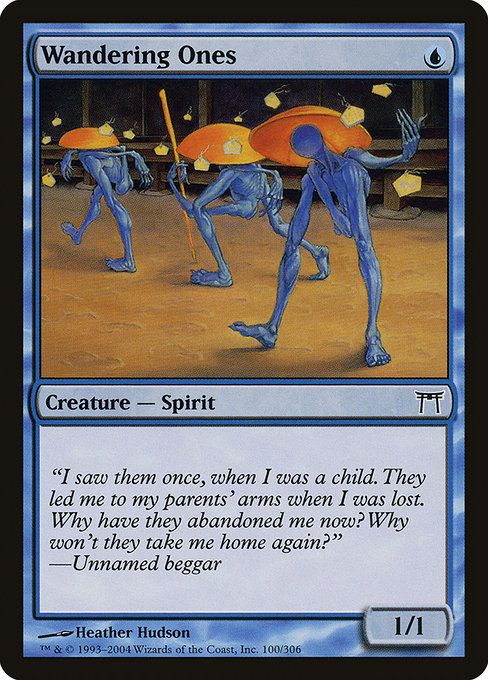
Image courtesy of Scryfall.com
Wandering Ones and the Magic of Alternate Frame Art Versions
In the vast tapestry of MTG, card frames are as much a part of the experience as the spell you cast. Wandering Ones, a blue Spirit from Champions of Kamigawa, arrives with a crisp {U} mana cost and a humble 1/1 body. Its oracle text is empty, but its flavor text speaks volumes: a beggar recalling a path back to family, a thread of memory that colors the card with quiet melancholy. This is blue storytelling in a single line: subtle, elusive, and very much in keeping with the Spirit creature type. 🧙♂️
What makes an alternate frame art version so compelling isn’t just a cosmetic change; it’s a dialogue between collectors and the art itself. Across MTG history, players have chased variants that present familiar scenes in new clothes: different borders, retouched color palettes, or borderless canvases that let the art breathe. Wandering Ones sits squarely in that conversation because it’s a blue, 1/1 Spirit with a historically clean, early-2000s frame. The original 2003 frame tends to emphasize crisp lines and a denser background, which can make subtle mood shifts in the art read more like a whispered memory than a bright moment. 🔥
From a gameplay perspective, Wandering Ones doesn’t rely on text to define its role in a deck; it’s a sweet, low-cost color option in formats where 1/1 Spirits have a home. In CCG terms, its lack of keywords means it’s a canvas for interaction: its strength comes from what you can do with it, not what it does on the card. That’s where alternate art variants become particularly fascinating. A frame that broadens negative-space behind the figure or shifts the color balance toward cooler blues can feel like the same creature is stepping out of a dream rather than stepping onto the battlefield. It’s a reminder that card art is a narrative device: it invites you to imagine the story you’re playing with. 🎨🎲
“I saw them once, when I was a child. They led me to my parents' arms when I was lost. Why have they abandoned me now? Why won't they take me home again?” —Unnamed beggar
The flavor text anchors Wandering Ones as a card with humanity beneath its veil of blue. When you compare alternate frames, you’re not just evaluating a color tone or a border; you’re weighing how the art carries mood, character, and lore. Some collectors prize border variations for the historical footprint they offer—how a piece of a story changes with printing conventions, how a single line can lean toward a painterly, impressionistic vibe in one frame and a more graphic, high-contrast look in another. The 2003 frame used for this card’s CHK printing is known for a certain clarity and a tactile sense of the card’s edges, which appeals to players who appreciate a “classic” Magic aesthetic. 🧙♂️
What to look for when comparing frames
- Color balance: Do blues feel cooler or warmer? How does the skin tone or background interact with the blue mana tint?
- Line quality: Are the outlines crisp, or is there a painterly softness? This affects legibility in played cards and the sense of atmosphere in art prints.
- Background depth: Does the frame emphasize the foreground figure or pull you into a dreamlike milieu?
- Frame density: Some variants push the art closer to the card edge, while others create larger borders that frame the image like a gallery piece.
- Rarity cues and foil treatment: Even though Wandering Ones is a common, foil vs nonfoil can shift how the frame is perceived in person, adding a tactile layer to your evaluation. 💎
For fans who are excited by the cross-section of art and collectibility, alternate frames can be the difference between a card you own and a card you’re proud to display. The Wandering Ones card here, with its 1/1 body and its flavor-rich quote, offers a neat case study: a simple creature whose presence invites you to contemplate how different art directions alter your memory of the moment. And if you’re thinking about building a Kamigawa-inspired blue shell, the exact frame you choose may influence not only how your deck feels but how your opponents perceive the mood you’re trying to evoke. ⚔️
As you’re exploring variants, consider how modern reprints, borderless editions, and artist-authenticated pieces interact with the original’s vibe. The CHK edition shows how early 2000s art could be complemented by a more restrained frame, while alternate frames in other sets often push the art into bold focus or experimental presentation. The art’s creator, Heather Hudson, crafts a moment that invites a story—one that can be reinterpreted by your chosen frame, your lighting, and the card’s placement in your binder. 🧙♂️
For readers who enjoy a broader look at the MTG landscape, the following links dive into related topics—from base-set fundamentals to anti-censory design choices and the cultivation of in-game spaces where vintage frames feel newly minted. Each piece offers a doorway into a facet of Magic that intersects with the aesthetic choices we see in Wandering Ones. 🔥
Custom Gaming Mouse Pad 9x7in Neoprene Stitched EdgesMore from our network
- https://crypto-acolytes.xyz/blog/post/mastering-the-compound-base-in-rust-a-step-by-step-guide/
- https://blog.digital-vault.xyz/blog/post/speakeasy-server-crafting-custom-proxies-and-alt-art-variants/
- https://transparent-paper.shop/blog/post/designing-modern-infographic-templates-that-boost-engagement/
- https://blog.digital-vault.xyz/blog/post/renata-called-to-the-hunt-mtg-fanfiction-chronicles/
- https://crypto-acolytes.xyz/blog/post/top-zombie-survival-blockchain-games-to-play/